window PONTIAC GRAND AM 1998 Owners Manual
[x] Cancel search | Manufacturer: PONTIAC, Model Year: 1998, Model line: GRAND AM, Model: PONTIAC GRAND AM 1998Pages: 370, PDF Size: 16.11 MB
Page 6 of 370
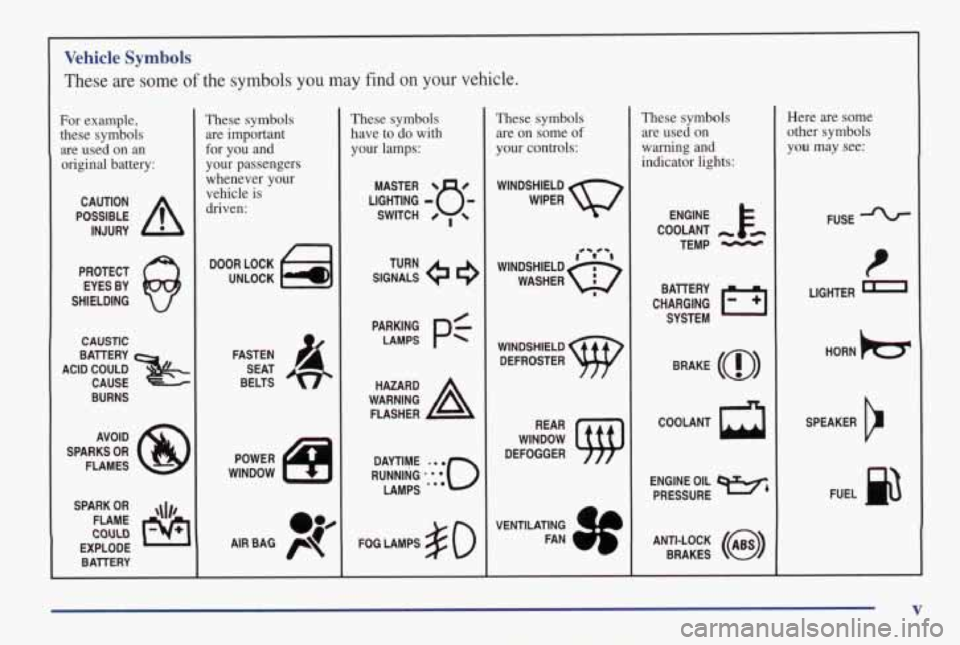
Vehicle Symbols
These are some of the symbols you may find on your vehicle.
For example,
these symbols
are used on an
original battery:
POSSIBLE A
CAUTION
INJURY
PROTECT EYES BY
SHIELDING
CAUSTlC
ACID COULD x
BAllERY
CAUSE
.~ .. ~
BURNS
AVOID
SPARKS
OR
FLAMES
FLAME
EXPLODE BAllERY
These symbols are important
for you and
your passengers
whenever your vehicle is
driven:
FASTEN
SEAT
BELTS
POWER
WINDOW
These symbols
have
to do with
your lamps:
SIGNALS 6
TURN
PARKING
PC
LAMPS
FOG LAMPS # 0
These symbols
are on some
of
your controls:
WINDSHIELD
DEFROSTER
WINDOW
DEFOGGER
VENTILATING
These symbols are used on
warning and
indicator lights:
COOLANT -
TEMP -
CHARGING I-1
BATTERY
SYSTEM
BRAKE
(a)
COOLANT a
ENGINE OIL w,
PRESSURE
ANTI-LOCK
(e)
BRAKES
Here are some
other symbols
you
may see:
FUSE
LIGHTER
n
HORN )tr
SPEAKER
b
FUEL p3
V
Page 33 of 370
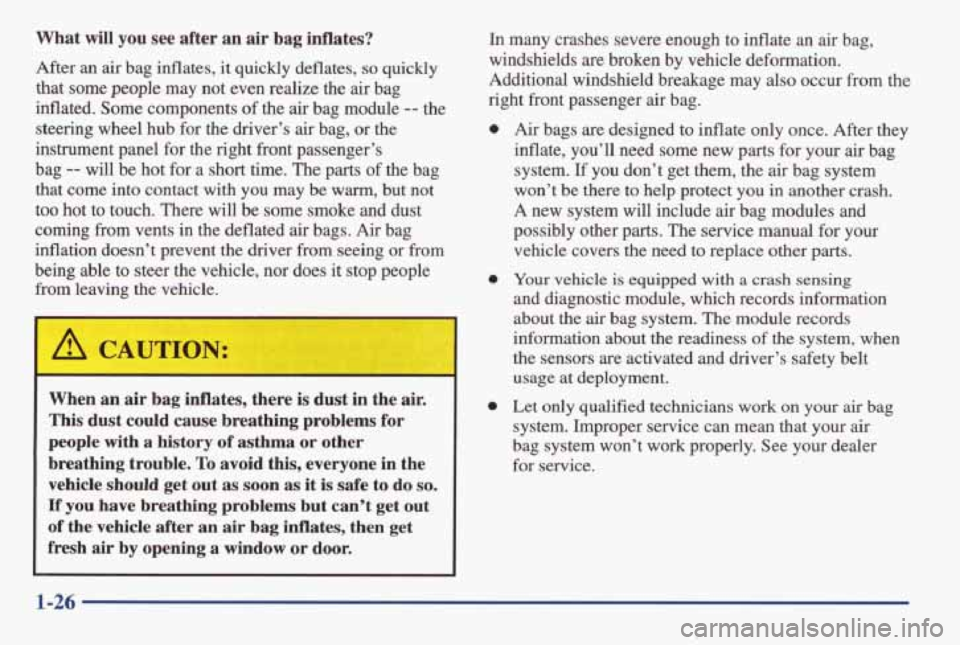
What will you see after an air bag inflates?
After an air bag inflates, it quickly deflates, so quickly
that some people may not even realize the
air bag
inflated. Some components of the
air bag module -- the
steering wheel hub for the driver’s
air bag, or the
instrument panel for the right front passenger’s
bag
-- will be hot for a short time. The parts of the bag
that come into contact with you may be
warm, but not
too hot to touch. There will be some smoke and dust
coming from vents
in the deflated air bags. Air bag
inflation doesn’t prevent the driver from seeing or from
being able to steer the vehicle, nor does it stop people
from leaving
the vehicle.
I
CAUTION:
I
When an air bag inflates, there is dust in the air.
This dust could cause breathing problems for
people with
a history of asthma or other
breathing trouble. To avoid
this, everyone in the
vehicle should get out as soon
as it is safe to do so.
If you have breathing problems but can’t get out
of the vehicle after an air bag inflates, then get
fresh air by opening a window or door.
In many crashes severe enough to inflate an air bag,
windshields are broken by vehicle deformation.
Additional windshield breakage may
also occur from the
right front passenger
air bag.
0
0
Air bags are designed to inflate only once. After they
inflate, you’ll need some new parts for
your air bag
system.
If you don’t get them, the air bag system
won’t be there
to help protect you in another crash.
A new system will include air bag modules and
possibly other parts.
The service manual for your
vehicle covers the need
to replace other parts.
Your vehicle is equipped with a crash sensing
and diagnostic module, which records information
about the
air bag system. The module records
information about the readiness of the system, when
the sensors are activated and driver’s safety belt
usage
at deployment.
Let only qualified technicians work
on your air bag
system. Improper service can mean that your
air
bag system won’t work properly. See your dealer
for service.
1-26
Page 35 of 370
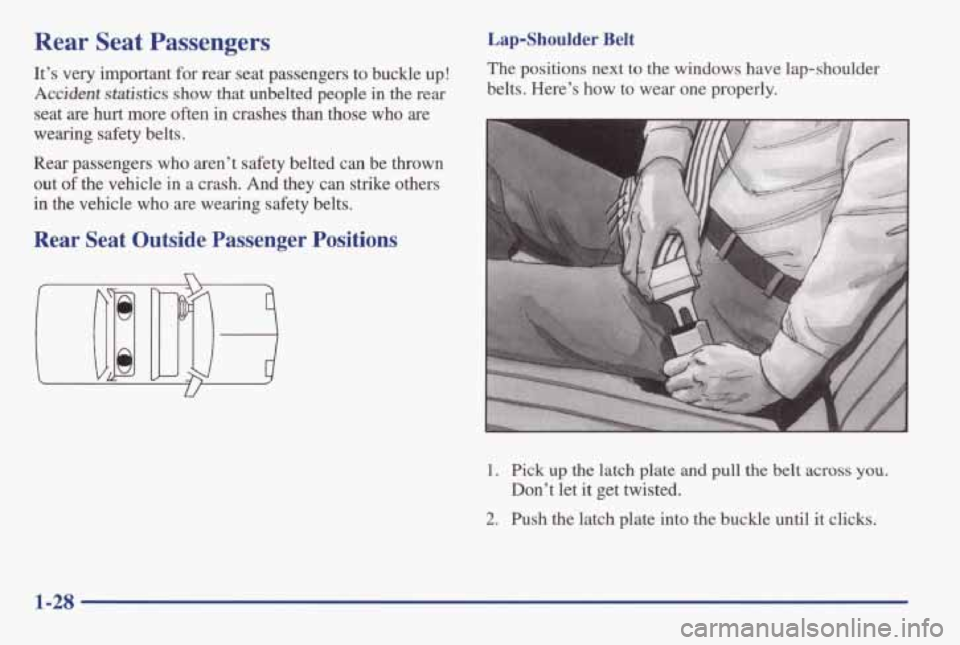
Rear Seat Passengers
It’s very important for rear seat passengers to buckle up!
Accident statistics show that unbelted people in the rear
seat are hurt more often in crashes than those who are
wearing safety belts.
Rear passengers who aren’t safety belted can be thrown
out
of the vehicle in a crash. And they can strike others
in the vehicle who are wearing safety belts.
Rear Seat Outside Passenger Positions
Lap-Shoulder Belt
The positions next to the windows have lap-shoulder
belts. Here’s how to wear one properly.
1. Pick up the latch plate and pull the belt across you.
2. Push the latch plate into the buckle until it clicks.
Don’t
let
it get twisted.
1-28
Page 48 of 370

A booster seat (F, G) is designed for children who
are about 40 to 60 lbs. (18 to 27 kg) and about four
to eight years of age.
It’s designed to improve the
fit of the vehicle’s safety belt system. Booster seats
with shields use lap-only belts; however, booster seats without shields use lap-shoulder belts.
Booster seats can also help a
child to see out
the window.
1-41
Page 56 of 370

5.
6.
To tighten the belt, pull up on the shoulder belt while
you push down on
the child restraint. You may find it
helpful to use your knee to push down on the child
restraint as you tighten the belt.
Push and pull the child restraint in different directions to be sure it is secure.
Larger Children
Children who have outgrown child restraints should
wear the vehicle's safety belts.
To remove the child restraint, just unbuckle the vehicle's
safety belt and let it go back
all the way. The safety belt
will move freely again and be ready to work for an adult
or larger child passenger. If you have the choice, a
child should sit next to a
window
so the child can wear a lap-shoulder belt and
get the additional restraint
a shoulder belt can provide.
1-49
Page 62 of 370

v
Section 2 Features and Controls
Here you can learn about the many standard and optional featur\
es on your vehicle, and information on starting, shifting and braking.
Also explained are the instrument panel and the warning systems that tell you if everythmg is
working properly -- and what to do if you have a problem.
2-2
2-4
2-7
2-11
2- 12
2- 13
2- 14
2- 14
2-
16
2- 19
2-2 1
2-25
2-27
2-28
2-30
Keys
Door
Locks
Keyless Entry System
TrUnk
Theft
Passlock@
New Vehicle “Break-In’’
Ignition Positions Starting Your Engine
Engine Coolant Heater
(If Equipped)
Automatic Transaxle Operation
Manual Transaxle Operation
Parking Brake
Shifting Into PARK
(P)
(Automatic Transaxle Only)
Shifting Out of PARK(P)
(Automatic Transaxle Models
Only)
2-30
2-3
1
2-3 1
2-32
2-33
2-34 2-34
2-42
2-44
2-47 2-48
2-50
2-5 1
2-52
2-56
Parking Your Vehicle
(Manual Transaxle Only)
Parking Over Things That
Burn
Engine Exhaust Running Your Engine While You’re Parked
(Automatic Transaxle)
Windows
Tilt Wheel (If Equipped)
Turn SignaVMultifunction Lever
Exterior Lamps
Interior Lamps
Mirrors Storage Compartments
Accessory Power Outlet
Sunroof
(If Equipped)
The Instrument Panel --Your
Information System
Warning Lights, Gages
and Indicators
2-1
Page 63 of 370
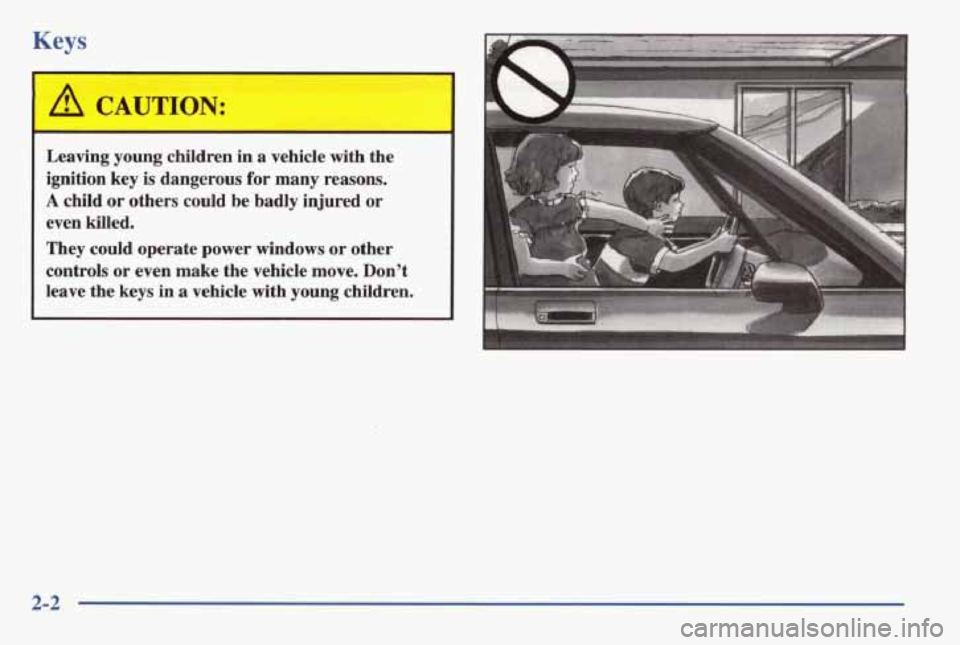
Keys
A CAUTION:
Leaving young children in a vehicle with the
ignition key is dangerous for many reasons.
A child or others could be badly injured or
even killed.
They could operate
power windows or other
controls or even make the vehicle move. Don’ t
leave the keys in a vehicle with young children.
2-2
Page 72 of 370
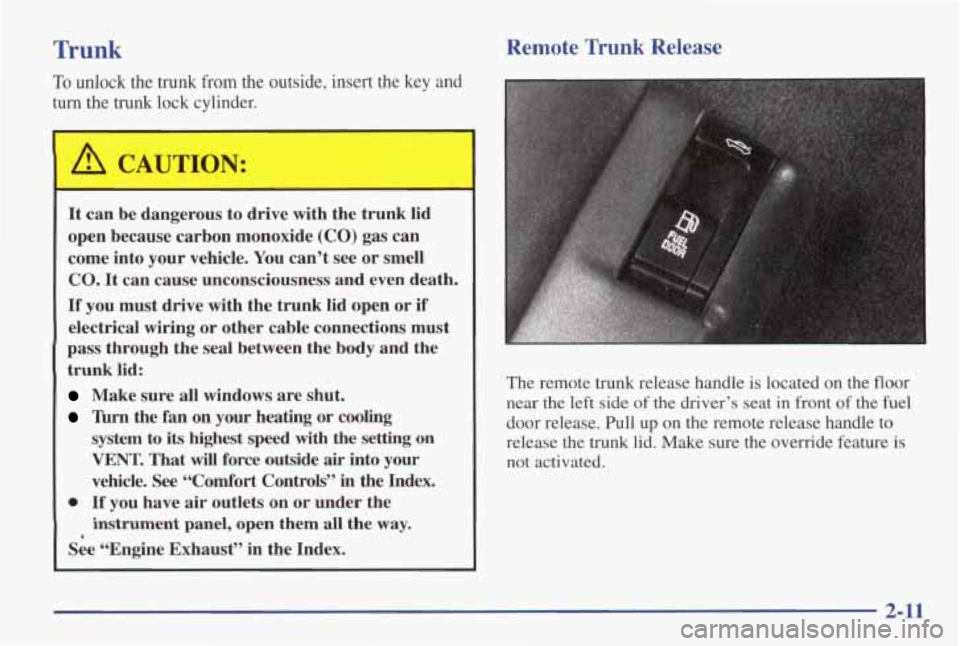
Trunk Remote Trunk Release
To unlock the trunk from the outside, insert the key and
turn the trunk lock cylinder.
1 A CAUTION:
It can be dangerous to drive with the trunk lid
open because carbon monoxide
(CO) gas can
come into your vehicle.
You can’t see or smell
CO. It can cause unconsciousness and even death.
If you must drive with the trunk lid open or if
electrical wiring or other cable connections must
pass through the seal between the body and the
trunk lid:
Make sure all windows are shut.
lbrn the fan on your heating or cooling
system
to its highest speed with the setting on
VENT. That will force outside air into your
vehicle. See “Comfort Controls” in the Index.
instrument panel, open them all the way.
0 If you have air outlets on or under the
See “Engine Exhaust” in the Index.
a
The remote trunk release handle is located on the floor
near the
left side of the driver’s seat in front of the fuel
door release. Pull up on the remote release handle
to
release the trunk lid. Make sure the override feature is
not activated.
2-11
Page 73 of 370
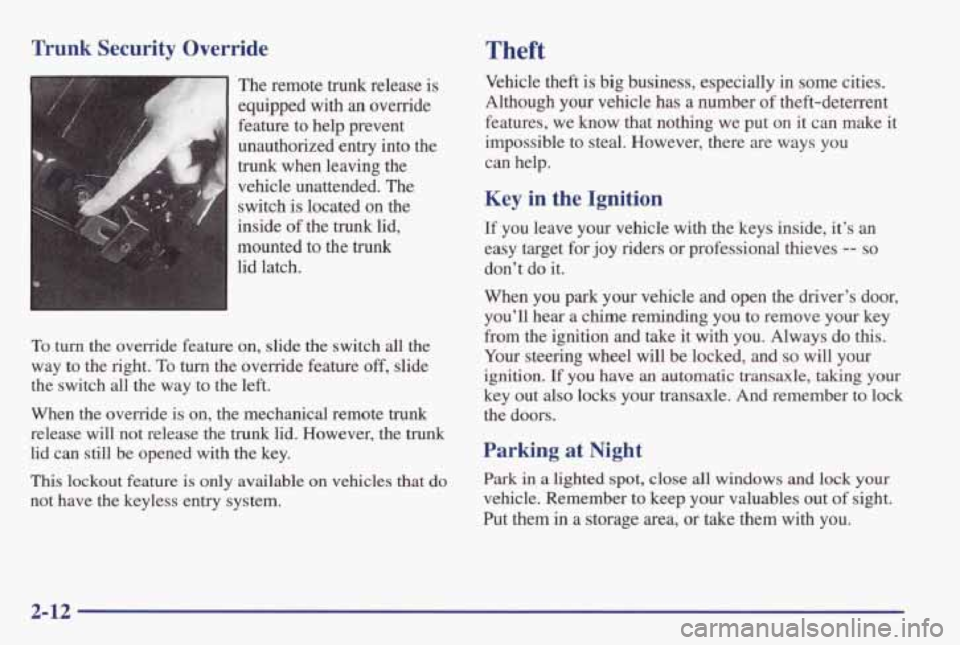
Trunk Security Override
The remote trunk release is
equipped with
an override
feature
to help prevent
unauthorized
entry into the
trunk when leaving the
vehicle unattended. The
switch
is located on the
inside
of the trunk lid,
mounted to the
trunk
lid latch.
To turn the override feature on, slide the switch all the
way to the right.
To turn the override feature off, slide
the switch all the way to the left.
When the override is on, the mechanical remote
trunk
release will not release the trunk lid. However, the trunk
lid can still be opened with the key.
This
lockout feature is only available on vehicles that do
not have the keyless entry system.
Theft
Vehicle theft is big business, especially in some cities.
Although
your vehicle has a number of theft-deterrent
features,
we know that nothing we put on it can make it
impossible to steal. However, there are ways you
can help.
Key in the Ignition
If you leave your vehicle with the keys inside, it’s an
easy target for joy riders or professional thieves -- so
don’t do it.
When
you park your vehicle and open the driver’s door,
you’ll hear a chime reminding you to remove your key
from the ignition and take it with
you. Always do this.
Your steering wheel will be locked, and
so will your
ignition. If you have an automatic transaxle, taking your
key out also locks your transaxle. And remember to lock
the doors.
Parking at Night
Park in a lighted spot, close all windows and lock your
vehicle. Remember to keep your valuables out of sight.
Put them in a storage area, or take them with
you.
2-12
Page 74 of 370

Parking Lots
If you park in a lot where someone will be watching
your vehicle, it’s best to lock it up and take your keys.
But what if
you have to leave your key?
0
0
0
a
0
0
If possible, park in a busy, well lit area.
Put your valuables in a storage area, like your
trunk or glove box. Be sure to close and lock the
storage area.
Close all windows.
Slide the remote trunk release lockout switch all the
way to the right.
Lock the glove box.
Lock all the doors except the driver’s.
Passlock@
Your vehicle is equipped with the Passlock
theft-deterrent system.
Passlock is a passive theft-deterrent system. The system
is armed once the key is removed from the ignition.
Passlock enables fuel if the ignition lock cylinder
is
turned with a valid key. If a correct key is not used, fuel
is disabled. During normal operation, the THEFT
SYS light will go
off after the engine is started.
If the engine stalls and the THEFT SYS light flashes,
wait until the light stops flashing before trying to restart
the engine. Remember to release the key from the START position as soon as the engine starts.
If
you are driving and the THEFT SYS light comes on,
you will be able to restart the engine if you turn the
engine
off. However, your Passlock system is not
working properly and must
be serviced by your dealer.
Your vehicle is not protected by Passlock at this time.
You may also want to check the fuse (see “Fuses and
Circuit Breakers” in the Index).
See your dealer
for service.
If the THEFT SYS light comes on while the engine is
running,
a problem has been detected and the system
may need service. See your dealer for service.
In an emergency, call the Pontiac Roadside Assistance
Center at 1 -800-ROADSIDE or 1-800-762-3743.
(In Canada, call 1-800-268-6800).
2-13